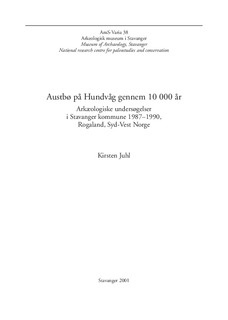| dc.description.abstract | In connection with a development plan on the east side of the island Hundvåg in the municipality of Stavanger, 27
prehistoric sites were surveyed and excavated between 1987 and 1990 under the supervision of the archaeologist,
curator Berit Gjerland. The plan area was 45.4 ha. Sites from nearly all prehistoric periods from the Early Mesolithic
to the end of the Wiking Age were discovered. One site kept its legal protection. All other sites belonged to the
category non-visible and were excavated. None of the sites were known in advance.
The exploitation of the area, and the development and changes in the prehistoric settlement pattern through time
was the main focus of the research project.
Stone Age settlement sites were abundant with artefact distribution areas amounting in total to 16.000–20.000
m2, corresponding to 3.5–4.5% of the total plan area. All sub-periods of the Mesolithic and the Neolithic,
approximately 9500–1700 before Christ, are represented. This is rather unusual within such a small geographic
area.
The coastal landscape of the island changed dramatically trough the Stone Age due to pronounced shore-level
displacements. In spite of this, the coast line was characterised by three shallow inlets well into the Early Bronze
Age. Many of the Stone Age sites were accumulated multi-period settlements sites. The localisation factors seems to
have been more or less identical throughout the Stone Age, proximity to marine and coastal resources.
Two Early Mesolithic sites were typologically pure (loc. 1, 26). One had a limited area of only 28.5 m2 comprising
four distinct find concentrations (loc. 26). It was interpreted as an artefact production site. On loc. 1 a possible
tent ring was found.
Three Middle Mesolithic sites were transgressed during the Tapes-transgression. On loc. 2, both the site itself and
the find material seemed very little affected by the transgression. Important osteological material was found.
Possible wall ditches belonging to houses or huts were found on the Late Mesolithic loc. 4/12A.
On the typologically pure Middle Neolithic site loc. 12 an undisturbed cultural layer was deposited within a time
span of 150–700 years. The find material included sherds from corded ware ceramics and an important and
relatively large, but strongly fragmented osteological material.
From the Late Neolithic onwards, 14C-dated settlement structures dominate the material. Well into the Early Pre-
Roman Iron Age there is a distinct cluster of agricultural settlement sites in the southern part of the plan area (loc.
20, 21, 19, 4 and 22). They seem to represent a settlement area with site continuity for at least one, maybe a few
farms.
On loc. 20 two differently constructed three-aisled long-houses replaced one another in the Early Bronze Age,
sometime between BC 1500–1400. Both had at least two phases and a comparatively long lifetime, probably 120–
140 years. Important macrofossil material was found. In the end of one of houses, an at least 500–1000 years elder
grain roasting device, baking shelf or the like was found.
Between the Late Neolithic and the end of the Early Bronze Age a cultural layer covering an area of 2000–2400 m2
was acculmulated on loc. 4. Through this deposit of ashes and other contents of fireplaces and cooking pits a
valuable tillage was built up. It may represent a small field.
On loc. 21 a small three-aisled long-house, probably with a clay floor or a clay-and-doub wall, was 14C-dated to the
Late Bronze Age/Early Pre-Roman Iron Age. Another, U-shaped house on the same site may belong to the same
period.
In later prehistoric periods settlement structures are more sporadically demonstrated, both in this particular area
and in other parts of the plan area. The youngest structures found are a four posts structure and a fireplace 14Cdated
to the Viking Age (loc. 20). | nb_NO |

